LatestBrowse by type
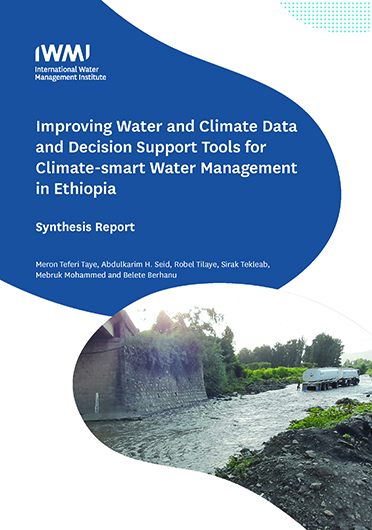
Improving water and climate data and decision support tools for climate-smart water management in Ethiopia. Synthesis report prepared by the Prioritization of Climate-smart Water Management Practices project
Water is the medium through which most impacts of climate change on people’s livelihoods and ecosystems are transmitted. Climate change can lead to increasing scarcity of water, intensify variability in rainfall and, thereby, river discharge; and exacerbate the severity of flood, drought and heatwave extremes. Reducing climate-induced water scarcity and enhancing climate resilience to water-related hazards requires well-thought-out actions that include water infrastructure development, putting in place adaptive institutional frameworks, and increasingly developing and employing innovations and future-oriented climate and water data and decision support systems. This report is one of the outputs of the study conducted by the International Water Management Institute (IWMI) as part of the project Prioritization of Climate-smart Water Management Practices. The aim of the study has been to develop recommendations for addressing two of the critical gaps identified for improving climate resilience of water resources management in Ethiopia, namely, (1) inadequate data and information on key hydrological variables that have led to a lack of recent knowledge on water availability, actual water use, water source types and potentials; and (2) a lack of decision support tools that would provide strategic and operational level information and capacity for risk-based planning and management of water resources. The report is based on an analysis of collected data, information gleaned through stakeholder consultations and a review of existing literature on climate and water data, and decision support tools in use in the Awash River Basin and at national level in Ethiopia. This synthesis report focuses on the technical aspects of climate and water data and decision support tools, while the institutional aspects are presented in Sanchez Ramirez et al. 2024.
; This study conceptualizes climate-smart water management as having three reinforcing objectives: maximize the goods and services that can be produced from the limited water resources; minimize the impact of climate extremes — floods and droughts at multiple scales; curtail the impact of rainfall variability across scales, including small-scale agricultural producers, and enhance water resources planning and management at the basin scale.
; Key challenges that have been identified include inadequate spatial coverage of hydrometeorological networks; short and, very often, intermittent river discharge data; almost nonexistent water use monitoring; fragmentation of data and inadequate capacity of skilled personnel. There are a number of ongoing efforts by the Ministry of Water and Energy with the aim of addressing these challenges. Weather forecasts are made regularly by the Ethiopian Meteorology Institute (EMI) with attempts to translate these forecasts into their potential impacts on agriculture, water and health. These forecasts and their translation into sector-specific implications need to be improved to make
Institutions / Weather forecasting / Early warning systems / Databases / Climate services / Groundwater / Monitoring / Water use / Water availability / Water resources / Climate change / Decision-support systems / Climatic data / Water management
Record No:H052695
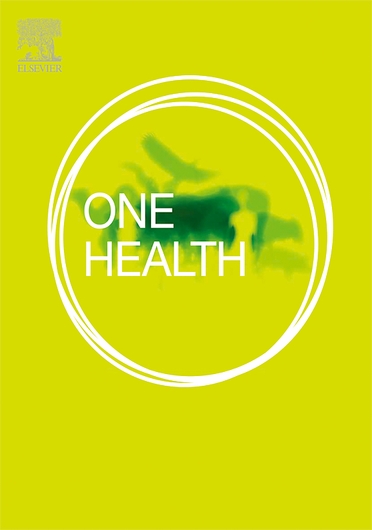
Navigating One Health in research-for-development: reflections on the design and implementation of the CGIAR Initiative on One Health
Adopting One Health approaches is key for addressing interconnected health challenges. Yet, how to best put One Health into practice in research-for-development initiatives aiming to ‘deliver impacts’ remains unclear. Drawing on the CGIAR Initiative on One Health – a global initiative to address zoonotic diseases, antimicrobial resistance, and food and water safety – we reflect on challenges during program conception and implementation, prompting us to suggest improvements in multisectoral collaboration, coordination, and communication. Our approach involves conducting a researcher-centered process evaluation, comprising individual interviews that are subsequently thematically analyzed and synthesized. The key takeaway is that limited time for planning processes and short program timelines compared to envisioned development impacts may impede research-for-development efforts. Yet, collaborative work can be successful when adequate time and resources are allocated for planning with minimal disruption throughout implementation. Additionally, due to the multifaceted nature of One Health initiatives, it is important to pay attention to co-benefits and trade-offs, where taking action in one aspect may yield advantages and disadvantages in another, aiding to identify sustainable One Health development pathways. Forming close partnerships with national governments and local stakeholders is essential not only to promote sustainability but also to ensure local relevance, enhancing the potential for meaningful impact. Finally, regularly assessing progress toward development goals is critical as development stands as an overarching objective.
Institutions / Collaboration / Initiatives / Research programmes / CGIAR / One Health approach / Research for development
Record No:H052588
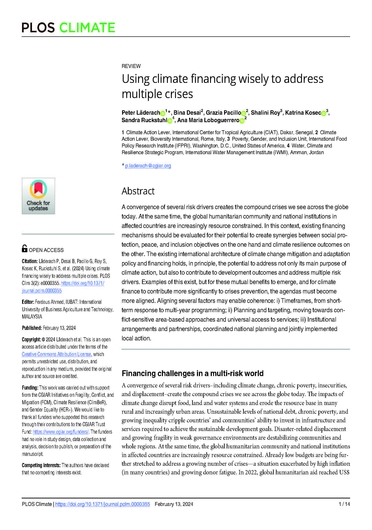
Using climate financing wisely to address multiple crises
A convergence of several risk drivers creates the compound crises we see across the globe today. At the same time, the global humanitarian community and national institutions in affected countries are increasingly resource constrained. In this context, existing financing mechanisms should be evaluated for their potential to create synergies between social protection, peace, and inclusion objectives on the one hand and climate resilience outcomes on the other. The existing international architecture of climate change mitigation and adaptation policy and financing holds, in principle, the potential to address not only its main purpose of climate action, but also to contribute to development outcomes and address multiple risk drivers. Examples of this exist, but for these mutual benefits to emerge, and for climate finance to contribute more significantly to crises prevention, the agendas must become more aligned. Aligning several factors may enable coherence: i) Timeframes, from short-term response to multi-year programming; ii) Planning and targeting, moving towards conflict-sensitive area-based approaches and universal access to services; iii) Institutional arrangements and partnerships, coordinated national planning and jointly implemented local action.
Water systems / National planning / Partnerships / Institutions / Policies / Risk reduction / Climate resilience / Financing / Climate change adaptation
Record No:H052589
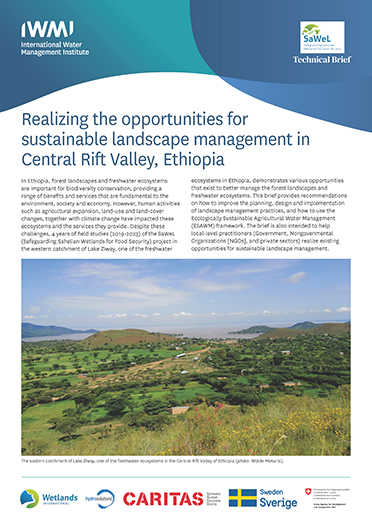
Realizing the opportunities for sustainable landscape management in Central Rift Valley, Ethiopia
In Ethiopia, forest landscapes and freshwater ecosystems are important for biodiversity conservation, providing a range of benefits and services that are fundamental to the environment, society and economy. However, human activities such as agricultural expansion, land-use and land-cover changes, together with climate change have impacted these ecosystems and the services they provide. Despite these challenges, 4 years of field studies (2019-2023) of the SaWeL (Safeguarding Sahelian Wetlands for Food Security) project in the western catchment of Lake Ziway, one of the freshwater ecosystems in Ethiopia, demonstrates various opportunities that exist to better manage the forest landscapes and freshwater ecosystems. This brief provides recommendations on how to improve the planning, design and implementation of landscape management practices, and how to use the Ecologically Sustainable Agricultural Water Management (ESAWM) framework. The brief is also intended to help local-level practitioners (government, Nongovernmental organizations [NGOs], and private sectors) realize existing opportunities for sustainable landscape management.
Financing / Stakeholders / Local communities / Watershed management / Wetlands / Water management / Freshwater ecosystems
Record No:H052757

Crop mapping in smallholder farms using unmanned aerial vehicle imagery and geospatial cloud computing infrastructure
Smallholder farms are major contributors to agricultural production, food security, and socioeconomic growth in many developing countries. However, they generally lack the resources to fully maximize their potential. Subsequently they require innovative, evidence-based and lowercost solutions to optimize their productivity. Recently, precision agricultural practices facilitated by unmanned aerial vehicles (UAVs) have gained traction in the agricultural sector and have great potential for smallholder farm applications. Furthermore, advances in geospatial cloud computing have opened new and exciting possibilities in the remote sensing arena. In light of these recent developments, the focus of this study was to explore and demonstrate the utility of using the advanced image processing capabilities of the Google Earth Engine (GEE) geospatial cloud computing platform to process and analyse a very high spatial resolution multispectral UAV image for mapping land use land cover (LULC) within smallholder farms. The results showed that LULC could be mapped at a 0.50 m spatial resolution with an overall accuracy of 91%. Overall, we found GEE to be an extremely useful platform for conducting advanced image analysis on UAV imagery and rapid communication of results. Notwithstanding the limitations of the study, the findings presented herein are quite promising and clearly demonstrate how modern agricultural practices can be implemented to facilitate improved agricultural management in smallholder farmers.
Land cover / Land use / Farmers / Smallholders / Machine learning / Imagery / Unmanned aerial vehicles / Mapping / Crops
Record No:H052587
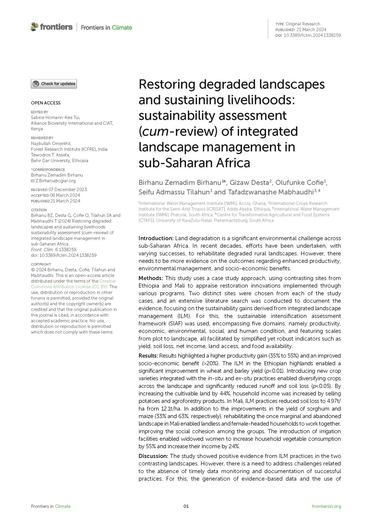
Restoring degraded landscapes and sustaining livelihoods: sustainability assessment (cum-review) of integrated landscape management in Sub-Saharan Africa
Introduction: Land degradation is a significant environmental challenge across sub-Saharan Africa. In recent decades, efforts have been undertaken, with varying successes, to rehabilitate degraded rural landscapes. However, there needs to be more evidence on the outcomes regarding enhanced productivity, environmental management, and socio-economic benefits.
Methods: This study uses a case study approach, using contrasting sites from Ethiopia and Mali to appraise restoration innovations implemented through various programs. Two distinct sites were chosen from each of the study cases, and an extensive literature search was conducted to document the evidence, focusing on the sustainability gains derived from integrated landscape management (ILM). For this, the sustainable intensification assessment framework (SIAF) was used, encompassing five domains, namely productivity, economic, environmental, social, and human condition, and featuring scales from plot to landscape, all facilitated by simplified yet robust indicators such as yield, soil loss, net income, land access, and food availability.
Results: Results highlighted a higher productivity gain (35% to 55%) and an improved socio-economic benefit (gt;20%). The ILM in the Ethiopian highlands enabled a significant improvement in wheat and barley yield (p lt; 0.01). Introducing new crop varieties integrated with the in-situ and ex-situ practices enabled diversifying crops across the landscape and significantly reduced runoff and soil loss (p lt; 0.05). By increasing the cultivable land by 44%, household income was increased by selling potatoes and agroforestry products. In Mali, ILM practices reduced soil loss to 4.97t/ha from 12.1t/ha. In addition to the improvements in the yield of sorghum and maize (33% and 63%, respectively), rehabilitating the once marginal and abandoned landscape in Mali enabled landless and female-headed households to work together, improving the social cohesion among the groups. The introduction of irrigation facilities enabled widowed women to increase household vegetable consumption by 55% and increase their income by 24%.
Discussion: The study showed positive evidence from ILM practices in the two contrasting landscapes. However, there is a need to address challenges related to the absence of timely data monitoring and documentation of successful practices. For this, the generation of evidence-based data and the use of advanced geo-spatial tools such as Remote Sensing and GPS-installed drones are recommended.
Climate change / Participatory research / Indicators / Livelihoods / Sustainability / Sustainable intensification / Land degradation / Landscape conservation
Record No:H052590
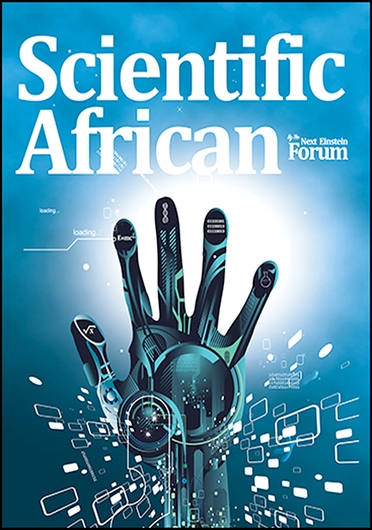
Modelling atmospheric behaviour over southern West Africa using RegCM 4.7.1: case assessment of relative humidity and zonal wind profiles based on the 2016 DACCIWA summertime field campaign
In this paper, we present an analysis of summertime atmospheric simulation (June–July 2016) for southern West Africa (sWA) using the RegCM 4.7.1 regional climate model to describe the atmospheric behaviour over the region, and also engage comparisons between the modelled data and observed upper air data acquired during the DACCIWA (Dynamics–Aerosol–Chemistry– Cloud Interactions in West Africa) field campaign period. First, assessments of relative humidity and zonal wind profiles were made for selected coastal and inland stations, to infer the relative vertical and temporal atmospheric differences for both locations. Thereafter, the model’s performance was evaluated, capturing an excessive wet bias in RH profiles of the model with accompanying reduced zonal winds at the Tropical Easterly Jet (TEJ) region and thus produces excessive upper tropospheric cloud liquid water content. Also, in the lower troposphere (particularly, the monsoon layer), RegCM 4.7.1 model captures adequate spatial differences in both RH and zonal wind profiles along the coast and inland. We judge this outcome to be a valuable contribution on the path to rendering RegCM4 a good tool for simulating atmospheric and climate dynamics in sWA.
Monsoons / Climate models / Modelling / Atmospheric pressure
Record No:H052501
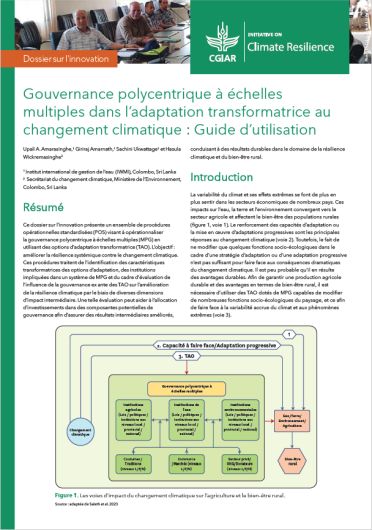
Gouvernance polycentrique chelles multiples dans l’adaptation transformatrice au changement climatique: guide d’utilisation. In French
Ce dossier sur l’innovation prsente un ensemble de procdures oprationnelles standardises (POS) visant oprationnaliser la gouvernance polycentrique chelles multiples (MPG) en utilisant des options d’adaptation transformatrice (TAO). L’objectif : amliorer la rsilience systmique contre le changement climatique. Ces procdures traitent de l’identification des caractristiques transformatrices des options d’adaptation, des institutions impliques dans un systme de MPG et du cadre d’valuation de l’influence de la gouvernance ex ante des TAO sur l’amlioration de la rsilience climatique par le biais de diverses dimensions d’impact intermdiaire. Une telle valuation peut aider l’allocation d’investissements dans des composantes potentielles de gouvernance afin d’assurer des rsultats intermdiaires amliors, conduisant des rsultats durables dans le domaine de la rsilience climatique et du bien-tre rural.
Case studies / Crops / Tanks / Drought tolerance / Irrigation systems / Stakeholders / Institutions / Governance / Rural welfare / Climate variability / Transformation / Climate resilience / Adaptation / Climate change
Record No:H052635
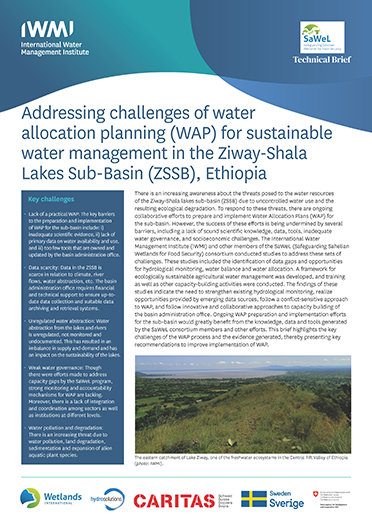
Addressing challenges of water allocation planning (WAP) for sustainable water management in the Ziway-Shala Lakes Sub-Basin (ZSSB), Ethiopia
There is an increasing awareness about the threats posed to the water resources of the Ziway-Shala lakes sub-basin (ZSSB) due to uncontrolled water use and the resulting ecological degradation. To respond to these threats, there are ongoing collaborative efforts to prepare and implement Water Allocation Plans (WAP) for the sub-basin. However, the success of these efforts is being undermined by several barriers, including a lack of sound scientific knowledge, data, tools, inadequate water governance, and socioeconomic challenges. The International Water Management Institute (IWMI) and other members of the SaWeL (Safeguarding Sahelian Wetlands for Food Security) consortium conducted studies to address these sets of challenges. These studies included the identification of data gaps and opportunities for hydrological monitoring, water balance and water allocation. A framework for ecologically sustainable agricultural water management was developed, and training as well as other capacity-building activities were conducted. The findings of these studies indicate the need to strengthen existing hydrological monitoring, realize opportunities provided by emerging data sources, follow a conflict-sensitive approach to WAP, and follow innovative and collaborative approaches to capacity building of the basin administration office. Ongoing WAP preparation and implementation efforts for the sub-basin would greatly benefit from the knowledge, data and tools generated by the SaWeL consortium members and other efforts. This brief highlights the key challenges of the WAP process and the evidence generated, thereby presenting key recommendations to improve implementation of WAP.
Freshwater ecosystems / Degradation / Decision-support systems / Water demand / Water extraction / Water levels / Water balance / Wetlands / Water use / Lakes / Planning / Water allocation / Water resources / Sustainable development / Water management
Record No:H052758
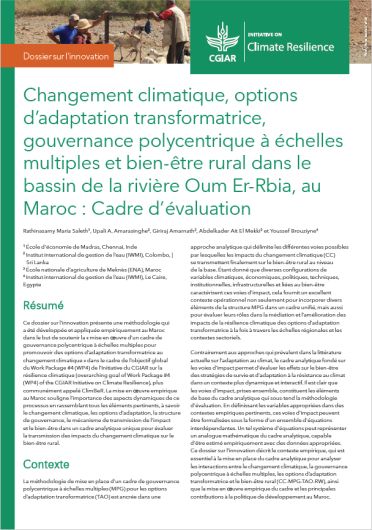
Changement climatique, options d’adaptation transformatrice, gouvernance polycentrique chelles multiples et bien-tre rural dans le bassin de la rivire Oum Er-Rbia, au Maroc: Cadre d’valuation. In French. Dossier sur l’innovation
Ce dossier sur l’innovation prsente une mthodologie quia t dveloppe et applique empiriquement au Maroc dans le but de soutenir la mise en oeuvre d’un cadre de gouvernance polycentrique chelles multiples pour promouvoir des options d’adaptation transformatrice au changement climatique dans le cadre de l’objectif global du Work Package #4 (WP4) de I’Initiative du CGIAR sur la rsilience climatique (overarching goal of Work Package #4 (WP4) of the CGIAR Initiative on Climate Resilience), plus communment appel ClimBeR. La mise en oeuvre empirique au Maroc souligne l’importance des aspects dynamiques de ce processus en rassemblant tous les lments pertinents, savoir le changement climatique, les options d’adaptation, la structure de gouvernance, le mcanisme de transmission de l’impact et le bien-tre dans un cadre analytique unique pour valuer la transmission des impacts du changement climatique sur le bien-tre rural.
Water footprint / Public-private partnerships / Food production / Mathematical models / Policies / Rural welfare / Governance / Transformation / Climate resilience / Climate change
Record No:H052636
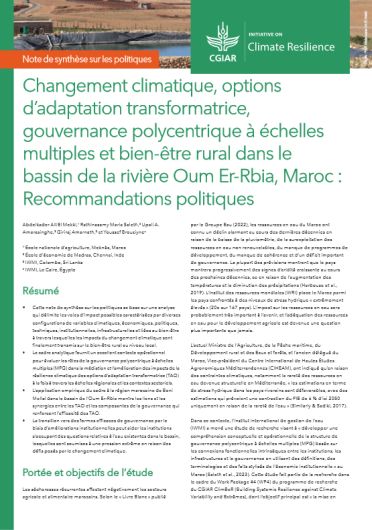
Changement climatique, options d’adaptation transformatrice, gouvernance polycentrique chelles multiples et bien-tre rural dans le bassin de la rivire Oum Er-Rbia, Maroc: recommandations politiques. In French. Note de synthse sur les politiques
Cette note de synthse sur les politiques se base sur une analyse qui dlimite les voies d’impact possibles caractrises par diverses configurations de variables climatiques, conomiques, politiques, techniques, institutionnelles, infrastructurelles et lies au bien-tre travers lesquelles les impacts du changement climatique sont finalement transmis sur le bien-tre rural au niveau local.
Le cadre analytique fournit un excellent contexte oprationnel pour valuer les rles de la gouvernance polycentrique chelles multiples (MPG) dans la mdiation et l’amlioration des impacts de la rsilience climatique des options d’adaptation transformatrice (TAO) la fois travers les chelles rgionales et les contextes sectoriels.
L’application empirique du cadre la rgion marocaine de Beni Mellal dans le bassin de l’Oum Er-Rbia montre les liens et les synergies entre les TAO et les composantes de la gouvernance qui renforcent l’efficacit des TAO.
La transition vers des formes efficaces de gouvernance par le biais d’amliorations institutionnelles peut aider les institutions s’occupant des questions relatives l’eau existantes dans le bassin, lesquelles sont soumises une pression extrme en raison des dfis poss par le changement climatique.
Households / Mathematical models / Drip irrigation / Public-private partnerships / Farming systems / Livestock / Infrastructure / Water institutions / Water security / Water resources / Policies / Rural welfare / Governance / Transformation / Climate resilience / Adaptation / Climate change
Record No:H052606
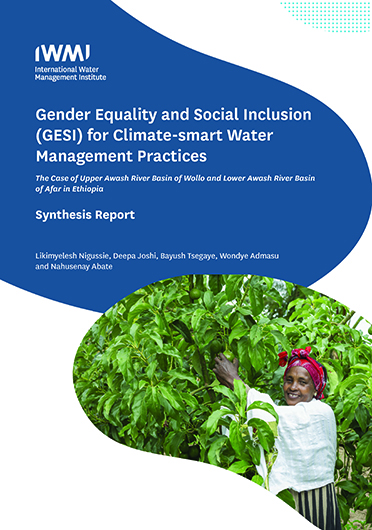
Gender Equality and Social Inclusion (GESI) for climate-smart water management practices: the case of Upper Awash River Basin of Wollo and Lower Awash River Basin of Afar in Ethiopia. Synthesis report prepared by the Prioritization of Climate-smart Water Management Practices project
This research study on gender and water resources management, led by the International Water Management Institute (IWMI) and its partners in Ethiopia, was designed to collect primary and secondary data on how smallholder agricultural producer communities in selected catchments are impacted by and cope with climate change. Our focus was on exploring opportunities and barriers for designing and implementing gender-responsive and climate resilient water resources planning and management interventions that are contextually relevant. The research findings will be further translated into actionable recommendations for gender-responsive decision support tools for climate-smart water resources management. The study, informed by the Gender Empowerment Framework and a qualitative research methodology, analyzed soil and water conservation initiatives and small-scale irrigation (SSI) interventions in four districts of the Awash River Basin. These locations were the Kalu and Habru districts from the Upper Awash Catchment in Wollo, and the Ewa and Afambo districts from the Lower Awash Catchment in Afar. These four districts were chosen for their diversity of conservation initiatives and livelihoods. Data were collected from a total sample size of 309 individuals – 288 of whom were smallholder farmers (160 women and 128 men) and 21 were key informants from local government offices – by conducting 96 in-depth interviews, 24 focus group discussions and 21 key informant interviews. The data were analyzed to assess the gender dynamics of productivity, production and practices, and SSI practices, focusing on three key dimensions: resources, agency and institutions. The three key results and recommendations are as follows:
First, climate impacts result in diverse outcomes for women (and men). It causes malnutrition in persons with special needs and increases the workload of women and girls, who are predominantly responsible for domestic work. This requires interventions that focus on the needs, priorities, barriers and challenges of these groups, and ensure targeted opportunities in decision-making, access to resources and services, and benefits.
Second, deep-rooted sociocultural norms and barriers impact outreach efforts for women and marginalized groups; this includes the effective engagement of these groups in capacity building training programs, and their access to relevant information, entrepreneurial opportunities and linkages across the value chains. Without addressing these barriers, making a sustained impact in terms of gender equality and social inclusion will not be possible. We recommend adopting interventions that address the structural barriers to women’s participation in leadership positions, promoting gender-responsive practices across institutions and building synergy among relevant stakeholders.
Third, insufficient institutional capacities among implementing actors present key obstacles to the design and implementation of gender-responsive climate-s
River basins / Households / Communities / Institutions / s empowerment / Womenapos / Small-scale irrigation / Farmers / Smallholders / Water management / Climate change / Social inclusion / Gender equality
Record No:H052586
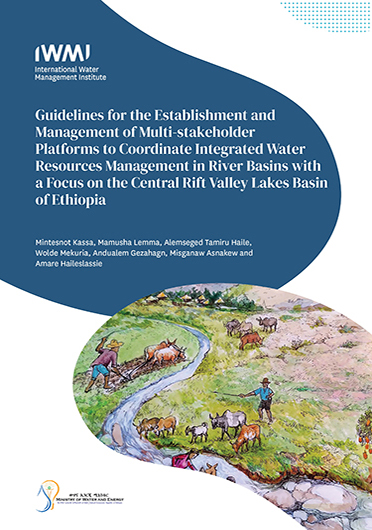
Guidelines for the establishment and management of multi-stakeholder platforms to coordinate integrated water resources management in river basins with a focus on the Central Rift Valley Lakes Basin of Ethiopia
Water resources policy in Ethiopia emphasizes the significance of integrated water resources management (IWRM) in river basins. The Ministry of Water and Energy (MoWE) with its different directorates is vested with the responsibility of coordinating water resource management across basins. As part of executing this mandate, MoWE initiated the preparation of guidelines for establishment and management of multi-stakeholder platforms (MSPs) to coordinate IWRM in various basins.; The guidelines presented in this publication focus on coordinating and managing water resources in the Central Rift Valley Lakes Basin within the Ethiopian Rift Valley Lakes Basin. This basin faces numerous water-related challenges such as increasing water demand, pollution, ecosystem degradation, climate change impacts, and conflicting water-use practices. These guidelines are aimed at defining a framework outlining the purpose, scope, and scale of MSPs as well as the key roles to be played by the governance bodies involved.; While facilitating collaboration and partnership among the stakeholders involved in basin water resources management, these guidelines explicitly emphasize inclusion of women and marginalized groups. They highlight the essential elements required for effective management and governance of MSPs and underline the need for facilitation, trust-building, planning, goal-setting, effective communication, and a commitment to participatory decision-making. Ultimately, MoWE bears the responsibility of making the final decisions.; Collaborative dialogue and inclusive decision-making processes are vital for sustainable water management. Integrated planning, data collection, monitoring, and evaluation are important for taking well-informed decisions. Therefore, our guidelines recommend capacity-building initiatives and knowledge-exchange platforms to enhance the effectiveness of MSPs. Additionally, strategies and mechanisms for securing the financial resources needed to implement IWRM plans and activities are emphasized.; As effective communication plays a vital role in MSP processes, there is a need to define objectives, identify stakeholders, select communication channels, establish communication protocols, build relationships and trust, and develop outreach materials.; Gender issues in water resources management, particularly access to water and control and ownership, are highlighted in these guidelines. Capacity-building activities are recommended to enhance the knowledge and skills of the stakeholders involved in the MSPs.; Lastly, the guidelines stress the importance of monitoring and evaluating the MSPs involved in basin management. Such evaluations involve measuring stakeholder engagement, policy alignment, knowledge sharing, and collaboration and partnerships.; These guidelines can be used by basin and sub-basin coordination experts and officials to establish and manage MSPs in the Central Rift Valley as well as beyond.
Integrated land management / Knowledge sharing / Communication / Accountability / Monitoring and evaluation / Financing / Learning / Capacity development / Marginalization / Social inclusion / Women / Gender / Local communities / Policies / Decision making / Partnerships / Collaboration / Sustainability / River basin management / Governance / Guidelines / Multi-stakeholder processes / Integrated water resources management
Record No:H052584
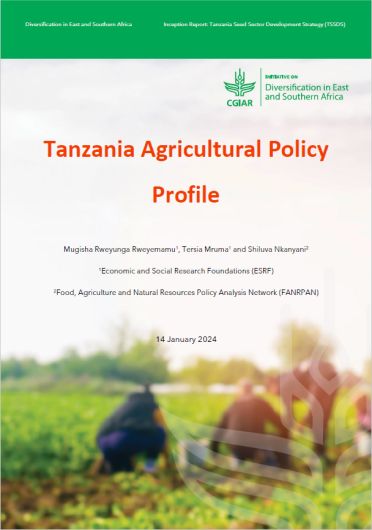
Tanzania agricultural policy profile
Tanzania places a significant emphasis on the importance of its agricultural sector, acknowledging its pivotal role in both the economy and the livelihoods of its citizens. The governmentapos;s commitment to the advancement of agriculture is evident through the execution of diverse policies and programs. The central pillar of Tanzaniaapos;s agricultural policies is the Agricultural Policy of 2013, which delineates strategies to boost productivity, ensure food security, and enhance the socio-economic conditions of farmers. The policy underscores the importance of sustainable practices and the adoption of technology.; Several key programs contribute to the realization of the regions agricultural policy objectives such as the Agricultural Sector Development Program (ASDP) II which focuses on modernizing agriculture, improving infrastructure, and enhancing market access. The Southern Agricultural Growth Corridor of Tanzania (SAGCOT) seeks to attract investments and boost agricultural productivity in the southern regions and the quot;Kilimo Kwanzaquot; initiative, meaning quot;Agriculture First,quot; emphasizes the prioritization of agriculture in national development. It encourages private sector involvement, technology adoption, and increased agricultural productivity.; Tanzania has made significant progress in agricultural development, marked by increased production and improved livelihoods. However, challenges persist, encompassing the impacts of climate change, issues related to market access, and the imperative for sustained policy implementation tailored to fortify the agricultural sectorapos;s resilience. The Tanzanian government remains steadfast in its commitment to advancing the agricultural sector. Future efforts are anticipated to emphasise the need for sustainable practices, technological innovations, and inclusive policies to address challenges and promote long-term growth.; In conclusion, Tanzaniaapos;s agricultural policy framework reflects a comprehensive approach to sector development. The implementation of key programs and initiatives demonstrates the governmentapos;s unwavering dedication to nurturing a robust, sustainable, and economically vibrant agricultural sector for the holistic benefit of its nation.
Indicators / Climate change / Food policies / Fisheries / Livestock / Oilseed plants / Cash crops / Strategies / Diversification / Agricultural production / Agricultural development / Agricultural sector / Agricultural policies
Record No:H052582

Stakeholders Inception Meeting: Tanzania Seed Sector Development Strategy (TSSDS)
On November 14, 2023, the Ministry of Agricultureapos;s Department of Crops Development (DCD) convened an Inception Meeting on the Seed Sector Development Strategy (SSDS) at the Gran Melia Hotel in Arusha, Tanzania supported by USAID through the SERA BORA project and CGIARapos;s Ukama Ustawi initiative. Attended by a diverse array of stakeholders, the meeting aimed to initiate discussions on the SSDS, marking a crucial step towards shaping a comprehensive and impactful strategy for Tanzaniaapos;s seed sector.; The meeting commenced with Professor David Nyange from the Agricultural Sector Policy and Institutional Reforms Strengthening Tanzania (ASPIRES TZ) welcoming participants and underscoring its significance as a benchmark for initiating the seed policy in Tanzania. Gratitude was extended to the Ministry of Agriculture, USAID, and CGIAR for their invaluable support and contributions. Mr. Samson Poneja, Assistant Director for DCD, emphasized the substantial role of agriculture in Tanzania and outlined challenges, stressing the need for improved seeds and a comprehensive seed strategy.; Dr. Inga Jacobs-Mata from the International Water Management Institute (IWMI) highlighted the Ukama Ustawi initiativeapos;s goal to address food and nutrition security risks, emphasizing the collaborationapos;s importance in ensuring the availability, accessibility, and sustainability of quality seeds. Mr. Poneja, in his official opening statement, acknowledged the challenges in the agriculture sector and proposed a seed strategy focusing on availability, accessibility, utilization, and sustainability.; Professor Nyange provided insights into the seed sectorapos;s current state, emphasizing the need for strategic planning. He outlined lower crop yields in Tanzania and proposed three key factors for improvement: enhanced genetic potential through improved seeds, soil health management, and improved agronomic practices.; Dr. Idil Ires presented the Ukama Ustawi Initiative, driven by the imperative to address maize cultivation vulnerability to climate change, which is structured into six work packages. The initiative supports over 1000 farmers and 50 agro-businesses with a substantial investment of US$100 million.; A compelling case was made for the development of the Tanzania Seed Sector Development Strategy, aligning with national policies. During group sessions, participants analyzed proposed strategies in thematic areas, including Seed Availability, Accessibility, Adoption, and Utilization. The meeting concluded with expressions of gratitude from a USAID representative and Professor Nyange, marking the official closure of the workshop.; The Inception Meeting served as a collaborative platform, bringing together key stakeholders to lay the groundwork for a strategic and sustainable transformation in Tanzaniaapos;s seed sector. The shared commitment and insights provided a robust foundation for the ongoing development of the SSDS.
Public-private partnerships / Sustainability / Agricultural policies / Stakeholders / Indicators / Strategies / Diversification / Agricultural sector / Seed production / Agricultural development
Record No:H052583
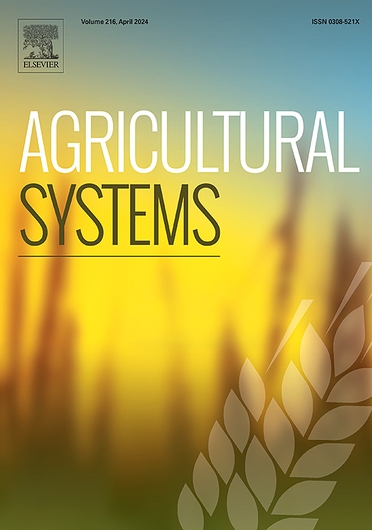
Fostering social inclusion in development-oriented digital food system interventions
CONTEXT: Digital innovations can enhance the participation of often-marginalized social groups – including women and resource-poor farmers in low- and middle-income countries – in sustainable, profitable food systems. But digital interventions can also reinforce existing inequities by further increasing the competitive advantage of user groups privileged with literacy, access to smartphones, or high investment capacity. To ensure that the digital transformation in the Global South leaves no one behind, therefore, deliberate efforts are needed to promote the inclusivity of emerging digital innovations. To date, however, there is a lack of practical guidelines and tools to critically assess, demonstrate, and enhance the inclusivity of digital food systems interventions. Too often, inclusivity remains a blurry concept and distant objective. In result, digital development researchers and practitioners have limited incentives for investing time and effort into safeguarding inclusivity.; OBJECTIVE: With this short communication, we intend to contribute to future, practice-oriented discussions about social inclusivity in development-oriented digital interventions for sustainable food systems. We provide a critical reflection on the current discourse around digital inclusion in development context and outline challenges and opportunities for considering inclusivity in the design and deployment of digital food system innovations.; METHODS: Drawing on literature as well as the authors’ own experiences with the design and implementation of digital innovations within research-for-development, we highlight ‘blind spots’ in the current discourse around digital inclusion in low- and middle-income country context. We then develop practical suggestions for overcoming these limitations.; RESULTS AND CONCLUSIONS: We propose a concrete agenda for enabling researchers and other innovation stakeholders, including donors, to contribute to more inclusive digital food system innovation in low- and middle-income countries. First, a standard concept and procedure is required for transparently assessing the inclusivity of digital services. Second, as many digital development stakeholders work under resource constraints, simple design tools can help them effectively consider social inclusion criteria during the design of digital solutions. Lastly, a stronger emphasis on inclusivity is required throughout the research-for-development system, ensuring that design processes themselves are inclusive, rather than considering only the final digital products.; SIGNIFICANCE: As the importance of digital innovation keeps growing within the wider agricultural development discourse, this article helps researchers and practitioners gain conceptual clarity on the goal of digital inclusion. Through concrete suggestions on how inclusivity could be considered in practice, the article promotes a more equitable, inclusive digital transformation of food systems.
Women / Social inclusion / Intersectionality / Information and Communication Technologies / Digital divide / Digital agriculture / Digital innovation
Record No:H052692
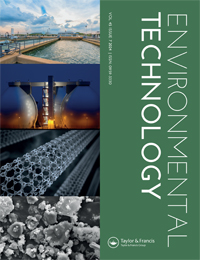
Storage duration and temperature affect pathogen load, heavy metals, and nutrient levels in faecal derived fertiliser
There are debates regarding the safety of faecal derived fertiliser (FDF) due to notions that harmful substances may persist at undetectable levels. A major concern is the recolonisation of indigenous pathogens and nutrient changes while undergoing storage. Abiotic factors such as duration and temperature on indigenous pathogen re-growth and nutrient during FDF storage have received little research attention. In this study, we assess the effect of varying storage temperature conditions and duration on indigenous E. coli re-growth and NPK changes of different FDF (enriched co-compost, NECo and co-compost, Co) during storage. A 2 × 3 × 6 factorial design was used with factors: fertiliser, temperature, and duration. The factorial had 36 experimental conditions in a completely randomised design with three replications. FDF samples were collected monthly for 6 months and analysed for pH, EC, organic carbon, N, NH4-N, NO3-N, P, K, E. coli, and total coliform. Findings show storage temperature and duration did not affect indigenous E. coli re-growth and total N in stored NECo and Co. However, NH4-N concentrations of NECo decreased between 27% and 55% with increasing duration of storage at lower temperatures (5C and 25C). The significance of this study for the FDF industry is that it is safe after storage and longer storage do not necessarily influence nutrient losses in stored FDF. Future studies are recommended to investigate the effect of moisture on stored FDF.
Escherichia coli / Nutrients / Heavy metals / Pathogens / Temperature / Storage / Fertilizers / Faecal sludge
Record No:H052687
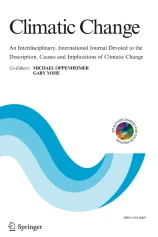
Flood risk assessment and adaptation under changing climate for the agricultural system in the Ghanaian White Volta Basin
In the context of river basins, the threat of climate change has been extensively studied. However, many of these studies centred on hazard analysis while neglecting the need for comprehensive risk assessments that account for exposure and vulnerability. Hazard analysis alone is not adequate for making adaptive decisions. Thus, to effectively manage flood risk, it is essential to understand the elements that contribute to vulnerability and exposure in addition to hazard analysis. This study aims to assess flood risk (in space and time until the year 2100) for the agricultural system, in the White Volta Basin in northern Ghana. Employing the impact chain methodology, a mix of quantitative and qualitative data and techniques were used to assess hazard, exposure, and vulnerability. Multi-model climate change data (RCP 8.5) from CORDEX and observation data from the Ghana Meteorological Agency were used for hazard analysis. Data on exposure, vulnerability, and adaptation were collected through structured interviews. Results indicate that flood hazard will increase by 79.1% with high spatial variability of wet periods but the flood risk of the catchment will increase by 19.3% by the end of the twenty-first century. The highest flood risk is found in the Upper East region, followed by North East, Northern, Savannah, and Upper West for all four analysed periods. Adaptive capacity, sensitivity, and exposure factors are driven by poverty, ineffective institutional governance, and a lack of livelihood alternatives. We conclude that the region is highly susceptible and vulnerable to floods, and that shifting from isolated hazard analysis to a comprehensive assessment that considers exposure and vulnerability reveals the underlying root causes of the risk. Also, the impact chain is useful in generating insight into flood risk for policymakers and researchers. We recommend the need to enhance local capacity and foster social transformation in the region.
Agriculture / Risk assessment / Disaster risk management / Flooding / Climate change adaptation
Record No:H052693
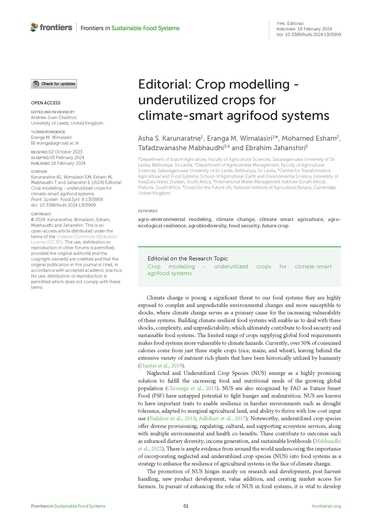
Crop modelling - underutilized crops for climate-smart agrifood systems. Editorial
Food security / Resilience / Agrobiodiversity / Climate change / Climate-smart agriculture / Underutilized species / Crop modelling
Record No:H052691
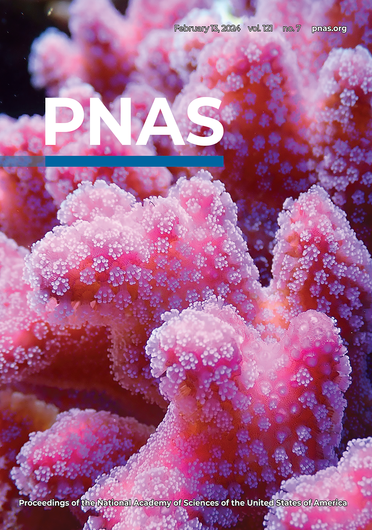
High life satisfaction reported among small-scale societies with low incomes
Global polls have shown that people in high-income countries generally report being more satisfied with their lives than people in low-income countries. The persistence of this correlation, and its similarity to correlations between income and life satisfaction within countries, could lead to the impression that high levels of life satisfaction can only be achieved in wealthy societies. However, global polls have typically overlooked small-scale, nonindustrialized societies, which can provide an alternative test of the consistency of this relationship. Here, we present results from a survey of 2,966 members of Indigenous Peoples and local communities among 19 globally distributed sites. We find that high average levels of life satisfaction, comparable to those of wealthy countries, are reported for numerous populations that have very low monetary incomes. Our results are consistent with the notion that human societies can support very satisfying lives for their members without necessarily requiring high degrees of monetary wealth.
Income / Livelihoods / Indigenous peoples
Record No:H052690
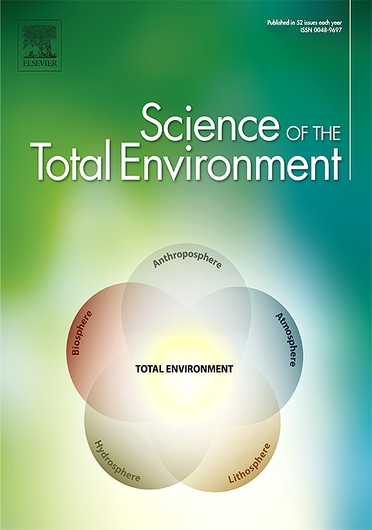
An evaluation of conventional and nature-based technologies for controlling antibiotic-resistant bacteria and antibiotic-resistant genes in wastewater treatment plants
Antibiotic resistance is a globally recognized health concern which leads to longer hospital stays, increased morbidity, increased mortality, and higher medical costs. Understanding how antibiotic resistance persists and exchanges in environmental systems like soil, water, and wastewater are critically important for understanding the emergence of pathogens with new resistance profiles and the subsequent exposure of people who indirectly/ directly come in contact with these pathogens. There are concerns about the widespread application of prophylactic antibiotics in the clinical and agriculture sectors, as well as chemicals/detergents used in food and manufacturing industries, especially the quaternary ammonium compounds which have been found responsible for the generation of resistant genes in water and soil. The rates of horizontal gene transfer increase where there is a lack of proper water/wastewater infrastructure, high antibiotic manufacturing industries, or endpoint users – such as hospitals and intensive agriculture. Conventional wastewater treatment technologies are often inefficient in the reduction of ARB/ARGs and provide the perfect combination of conditions for the development of antibiotic resistance. The wastewater discharged from municipal facilities may therefore be enriched with bacterial communities/pathogens and provide a suitable environment (due to the presence of nutrients and other pollutants) to enhance the transfer of antibiotic resistance. However, facilities with tertiary treatment (either traditional/emerging technologies) provide higher rates of reduction. This review provides a synthesis of the current understanding of wastewater treatment and antibiotic resistance, examining the drivers that may accelerate their possible transmission to a different environment, and highlighting the need for tertiary technologies used in treatment plants for the reduction of resistant bacteria/genes.
Constructed wetlands / Disinfection / Nature-based solutions / Resistance to antibiotics / Wastewater treatment plants
Record No:H052689
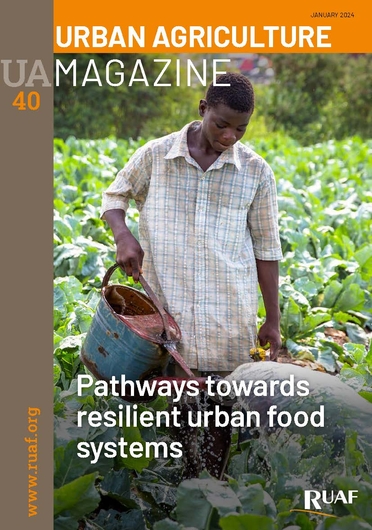
United for progress: Ghana’s multi-institutional circular bioeconomy Innovation Hub
After years of fragmented efforts to create circular approaches to waste management in Ghana, the new circular bio-economy (CBE) Innovation Hub in Ghana is bringing together diverse stakeholders to jointly promote existing CBE approaches through training, advice, demonstrations, and research, while fostering the development of new, accessible innovations.
Institutions / Training / Stakeholders / Reuse / Resource recovery / Waste management / Innovation / Bioeconomy / Circular economy
Record No:H052654
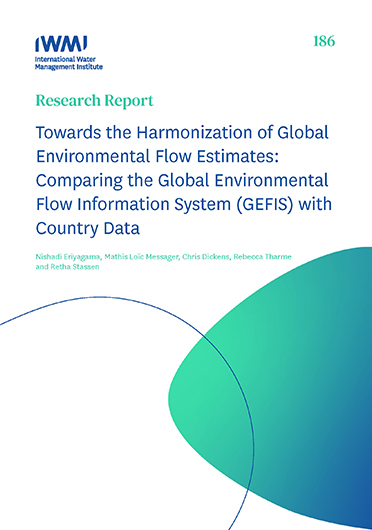
Towards the harmonization of global environmental flow estimates: comparing the Global Environmental Flow Information System (GEFIS) with country data
The source of data used to estimate the e-flow requirement in Sustainable Development Goal (SDG) Indicator 6.4.2 (level of water stress: freshwater withdrawal as a proportion of available freshwater resources) is the Global Environmental Flow Information System (GEFIS), an online tool produced and managed by the International Water Management Institute (IWMI). In addition to the GEFIS estimate, the Food and Agriculture Organization of the United Nations (FAO), as the custodians of the SDG indicator, encourages countries to put forward their locally determined e-flow estimates, especially if it differs from the GEFIS estimate. To date, however, only a few countries have taken up this opportunity. The aim of this report is to compare e-flows estimated by GEFIS with independent e-flow assessments performed at the local level to gauge the level of agreement between the two sets of estimates. We compared e-flow estimates from GEFIS to local e-flow estimates at 533 river sites.
Indexes / Indicators / Heterogeneity / Time series analysis / Tools / Hydrological modelling / Drainage area / Land cover / Catchment areas / Ecological factors / Habitats / Aquatic ecosystems / Runoff / Stream flow / Rivers / Water stress / Water resources / Freshwater / Goal 6 Clean water and sanitation / Sustainable Development Goals / Assessment / Comparisons / Databases / Hydrological data / Information systems / Estimation / Environmental flows
Record No:H052596
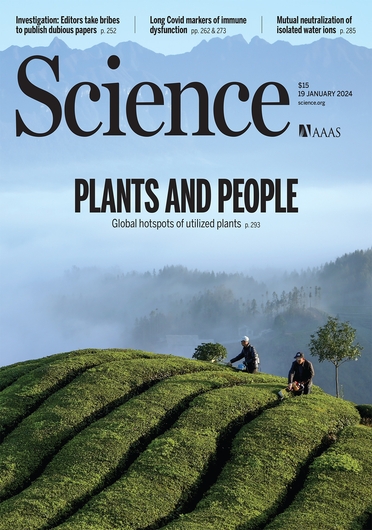
Risks from solar-powered groundwater irrigation
Carbon / Water use / Emission reduction / Pumps / Solar powered irrigation systems / Groundwater irrigation
Record No:H052565
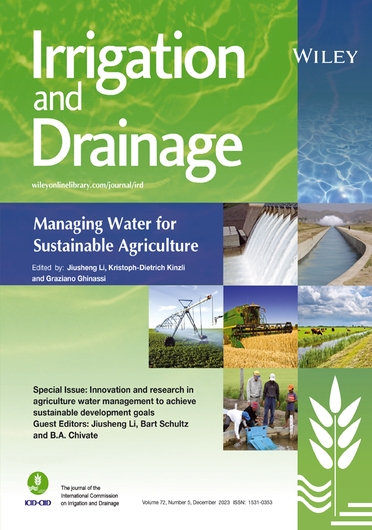
Technical and allocative efficiency of crop production using different storage and water-lifting technologies in Central Rift Valley, Ethiopia
Assessing the efficiency gains, in terms of crop production and productivity, of using agricultural water management is critical to understanding the comparative advantage of using different storage and water-lifting technologies in irrigation development. This study aims to compare the efficiency differences among irrigation farmers using various water-lifting technologies and among users of various technology suites in the Central Rift Valley, Ethiopia. Cross-sectional data collected from 320 randomly selected smallholder farmers, considering the 2019/2020 production season, were used to analyse a one-step Cobb–Douglas stochastic frontier function. The results of the study revealed the existence of technical and allocative efficiency differences between gravity and fuel pump users. Factors that positively determine the level of technical efficiency scores are gender, age, education status, technology type and extension contact. Irrigation experience, access to credit, training and technology type positively affected allocative efficiency, while the distance to the irrigation water source had a negative effect. The findings have important implications for agricultural policy and practice as improving efficiency through the adoption of fuel-powered water-lifting technology could further improve overall agricultural productivity. Designing small-scale friendly business models and promoting irrigation extension services, among others, is critical for scaling successful water management technologies.
Efficiency / Crop production / Water storage / Agricultural water management
Record No:H052572
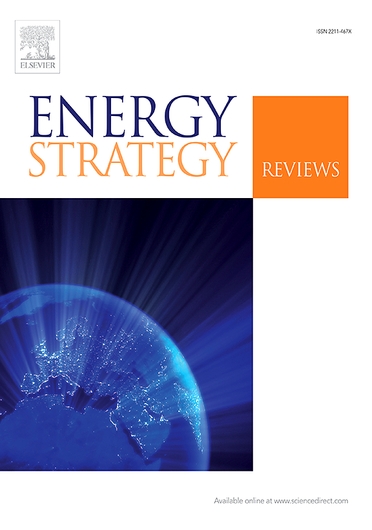
Barriers to the uptake of solar-powered irrigation by smallholder farmers in Sub-Saharan Africa: a review
Irrigation expansion is critical for agricultural and rural development, food and nutrition security, and climate change adaptation in Sub-Saharan Africa (SSA). Lack of accessible energy for irrigation development due to limited off- and on-grid infrastructure and the resulting dependence on costly fuel-based irrigation have been key inhibiting factors for irrigation expansion in the region. Off-grid solar-powered irrigation pumps (SIPs) can overcome many of the energy access and other challenges in the region, but their uptake has been slow. Given the nascent development of the solar irrigation sector in SSA, this paper combines a review of the peer-reviewed and grey literature with key informant interviews to identify systemic barriers to the adoption and growth of solar-powered irrigation. We identify uncovered risks, lack of incentives, and lack of capacity as the key factors limiting the adoption of solar-powered irrigation. Moreover, despite significant global cost reductions, solar-powered irrigation systems remain costly in SSA due to limited market development and geographical constraints. Lack of regulation and low investment in building local institutions and value chains further affect uptake and inhibit leveraging the energy transition for ensuring food security and agriculture-led poverty alleviation in SSA. We propose a move away from thinking of SIPs as “silver bullets” and towards a systems approach and the design of context-specific solutions to address risks, incentives and capacity challenges.
Pumps / Groundwater / Farmer-led irrigation / Smallholders / Barriers / Poverty alleviation / Energy security / Irrigation development / Solar powered irrigation systems
Record No:H052554
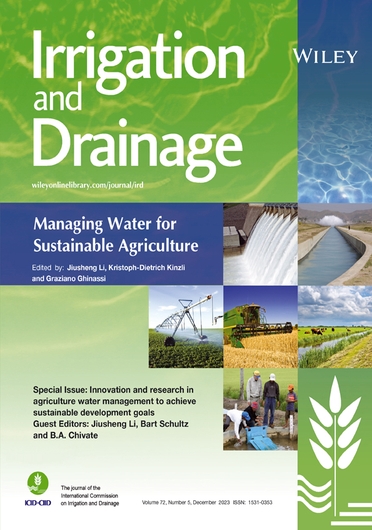
Farmers on the front line: perceptions, practices and discrepancies from the Aral Sea's Karakalpakstan and Khorezm regions
Undesirable changes in surface water and groundwater resources and land quality for biophysical and institutional reasons will further endanger the livelihoods of people in Central Asia. The farmersapos; understanding of these problems and the adaptation and solution strategies they opt for are the critical variables in devising relevant policies. Our findings captured significant disparities between farmer-perceived water shortages and officially documented water availability, as well as soil salinity discrepancies. Farmersapos; coping strategies, including crop alterations and water-saving measures, often lead to tradeoffs, such as reduced crop yields. The study highlights the need to consider farmer perceptions and practices along with official data when designing policies. Effective policymaking must consider this dynamic interplay and the multifaceted challenges faced by farmers in these vulnerable Aral Sea regions.
Groundwater / Water scarcity / Water shortages / Salinity / Farmers / Environmental factors
Record No:H052571
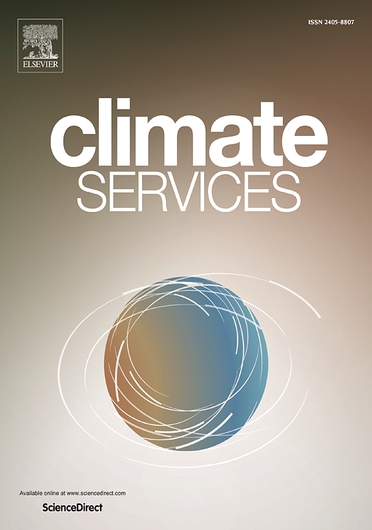
Assessing adaptive capacity of climate-vulnerable farming communities in flood-prone areas: insights from a household survey in South Punjab, Pakistan
Climate change poses a significant threat to agricultural systems worldwide. In Pakistan, an agrarian country where the majority of the population relies on agriculture for their livelihoods, the impacts of climate change can be particularly devastating. Understanding the adaptive capacity of farmers is crucial in order to identify effective strategies for coping with the impacts of climate change. This study aimed to assess the adaptive capacity of farmers in Rajanpur and Dera Ghazi Khan, two flood-prone districts of South Punjab, Pakistan. Data were collected in October 2022 from 448 farmers through multistage stratified random sampling, and multivariate regression and bivariate probit models were used to analyze the likelihood of farmers adopting certain joint strategies and the impact of socioeconomic factors on their decision-making. Results indicated that concern for climate change and knowledge of market value of crops were significant determinants for farmers adopting joint strategies, while farmers with more experience and alternate sources of income were less likely to do so. Increased irrigation was a top strategy used despite its potential negative environmental impacts. Findings highlight the need for a holistic approach to climate adaptation that considers complex social, economic, and environmental factors and appreciates the complex decision-making process that farmers undergo. Understanding the local context is key to developing effective interventions to support climate resilience and sustainable livelihoods in agricultural communities.
Household surveys / Communities / Vulnerability / Flooding / Strategies / attitudes / Farmersapos / Climate change adaptation
Record No:H052555
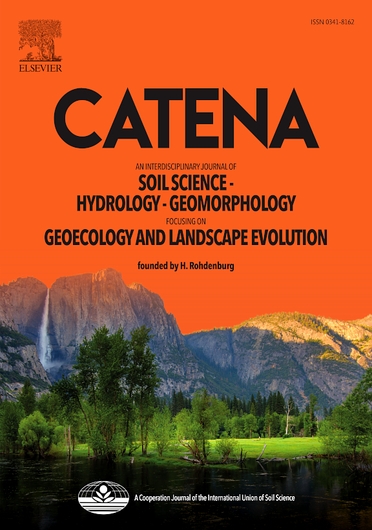
Evaluation of exclosures in restoring degraded landscapes in the semi-arid highlands of northwestern Ethiopia
Land degradation is a severe environmental problem in the northern and northwestern Ethiopian highlands. As a response to increasing land degradation, rehabilitation of degraded grazing lands through exclosures (exclusion of farmers and domestic animals) has been undertaken. This study aimed to evaluate the effectiveness of 11 and 8-year exclosures in improving degraded landscapes in the Karita-Wuha and Dengora watersheds. It was assumed that the conditions on communal grazing lands at the time of the investigation corresponded to those at the establishment of exclosures. Vegetation was inventoried, and soil samples were collected and analyzed in 14 and 21 sampling sites selected from exclosures and communal grazing lands in Dengora and Karita-Wuha watersheds, respectively. Sampling plots (20 × 20 m) were established for soil sampling. In the two land uses, 10x10 m and 5x5 m sub-plots were used to survey trees and bushes/shrubs, respectively. Richness, diversity, evenness, and aboveground biomass (AGB) were evaluated using measurements from the vegetation inventory. Organic carbon (OC), total nitrogen (TN), and available phosphorus (AP) and their stocks were used as soil nutrient indicators. The result showed that exclosures aided in restoring vegetation in both watersheds and soil nutrient parameters in the Dengora watershed compared with communal grazing lands. In the Karita-Wuha watershed, there was significantly higher OC, TN, and their stocks in communal grazing land than exclosures (t-test, p lt; 0.05). These results are generally attributed to the fact that communal grazing lands were significantly degraded before exclosure and have yet to recover. As a result, exclosures of Dengora and Karita-Wuha watersheds were limited in restoring degraded landscapes. There have been differences in the effectiveness of lt; 11- and gt; 11-year exclosures in restoring degraded landscapes in the literature. The effectiveness of various aged exclosures in restoring degraded landscapes is likely variable and dependent on local biophysical parameters and land use systems.
Common lands / Grazing lands / Semiarid zones / Exclosures
Record No:H052560
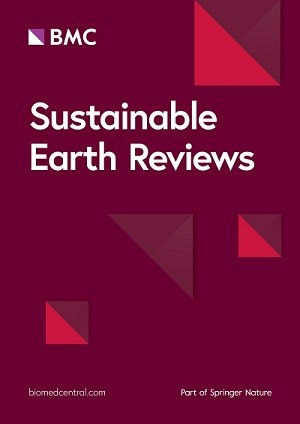
Local studies provide a global perspective of the impacts of climate change on indigenous peoples and local communities
Indigenous Peoples and local communities with nature-dependent livelihoods are disproportionately affected by climate change impacts, but their experience, knowledge and needs receive inadequate attention in climate research and policy. Here, we discuss three key findings of a collaborative research consortium arising from the Local Indicators of Climate Change Impacts project. First, reports of environmental change by Indigenous Peoples and local communities provide holistic, relational, placed-based, culturally-grounded and multi-causal understandings of change, largely focused on processes and elements that are relevant to local livelihoods and cultures. These reports demonstrate that the impacts of climate change intersect with and exacerbate historical effects of socioeconomic and political marginalization. Second, drawing on rich bodies of inter-generational knowledge, Indigenous Peoples and local communities have developed context-specific responses to environmental change grounded in local resources and strategies that often absorb the impacts of multiple drivers of change. Indigenous Peoples and local communities adjust in diverse ways to impacts on their livelihoods, but the adoption of responses often comes at a significant cost due to economic, political, and socio-cultural barriers operating at societal, community, household, and individual levels. Finally, divergent understandings of change challenge generalizations in research examining the human dimensions of climate change. Evidence from Indigenous and local knowledge systems is context-dependent and not always aligned with scientific evidence. Exploring divergent understandings of the concept of change derived from different knowledge systems can yield new insights which may help prioritize research and policy actions to address local needs and priorities.
Sociocultural environment / Local knowledge / Livelihoods / Local communities / Indigenous peoples / Climate change impacts
Record No:H052569
| Corporate Publications | Books | Water, Land & Ecosystems |
| Annual Reports | ||
| Brochures | ||
| Success Stories | ||
| IWMI Research Reports | ||
| IWMI Working Papers | Briefs | Conference Outputs |
| Journal Articles | ||
| CA Research Reports | ||
| Reports | ||
| Resource Recovery & Reuse Series | Theses | |
| IWMI-TATA Series | Pakistan Reports | |
| Latin American Series | SWIM Papers | |
| CA-CABI Series | ||

